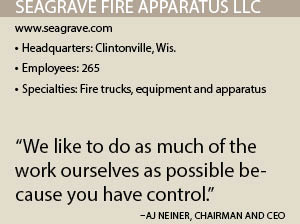Seagrave Fire Apparatus LLC
Total reliability is the result of design excellence, exacting specifications and process controls, which are necessary when you are providing products that save lives. So Seagrave Fire Apparatus LLC exercises discipline and control over its fire trucks, equipment and apparatus by designing, manufacturing and servicing them to specific customer requirements.
“A fire truck is a very complex vehicle, so if you outsource it, you’ve got to be very careful that parts are made to the same level of quality assured as when a company utilizes its own people and processes,” Chairman and CEO AJ Neiner emphasizes. “We’ve been in business since 1881. We have 135-plus years of experience; experience matters when you’re dealing with complex products in mission-critical situations. We like to do as much of the work ourselves as possible because we control the process.”
When ordering a fire truck or apparatus, Seagrave’s customers can choose the chassis, cab, body, pump and other features that are designed and built to their specific requirements. The weight of the fire truck and its body size determine tire size, suspension system, the type of engine and a whole host of other specifications.
Each fire truck requires 5,000 to 6,000 parts, so inventory requirements are high in the approximately 10,000-square-foot distribution center at the company’s headquarters in Clintonville, Wis. Neiner estimates that the company has $20 to $30 million in inventory at one time, of which $5 million to $6 million is in parts. That level of inventory is necessary because of the estimated lifetime of the company’s products, which is oftentimes 20-plus years. Some of its inventory also is at its sales and service centers in East Brunswick, N.J., and Rock Hill, S.C.
Bar coding is used to direct manual pickers through the warehouses selecting smaller parts such as lights or switches or using lift trucks for the larger parts, such as generators and swivels.
Manual Assembly
Most of the truck and product assembly is manual because of the lower quantities and unique aspects of the design of fire trucks that Seagrave produces. “We’re the best in the industry but not the biggest,” Neiner acknowledges. “Many competitors are substantially larger than us, but we concentrate on providing our customers with the best lifetime value in the business.
“That manual craftsmanship often produces higher quality and longer-lasting product life,” Neiner maintains. “We guarantee our frame rails and cross-members for life. We hand paint them.” Manual paint application often results in greater thickness, which lengthens the lifetime of the part. “We also paint parts before bolting them together,” Neiner notes. This means that seams and junctions are fully painted and do not succumb to rust as quickly as parts that are not painted until after they are assembled.
Seagrave Fire Apparatus produces fire trucks and equipment in its 500,000 square foot manufacturing plant on 63 acres in Clintonville. Manufacturing processes performed there include part fabrication in a machine shop with brake press, machining and metal-cutting areas, a paint and body shop, assembly and numerous testing procedures that ensure the quality of the fire truck.
 Lean Manufacturing
Lean Manufacturing
Lean manufacturing principles have been emphasized at the plant for the last five years but not identified as such. “We use more basic terms, like, ‘Do it right the first time,’” Neiner says. “It’s a lean principle. We use simple words like, ‘Measure twice, cut once,’ so we get to lean without using all of the textbook terminology.”
Seagrave Fire Apparatus has implemented new layouts for some areas of the plant. “We’ve put in new equipment for vibration testing to take the subjectivity out of quality measurements,” Neiner notes. “We built many new fixtures to ensure the consistency of our products and have standardized tools used in the factory.”
The company spent $300,000 to buy tools for its nearly 300 assembly employees so the same tools would be used by each employee for the same procedure to improve product consistency and standardized methods. This is an example of implementing best practices, Neiner points out. For the future, Neiner plans to purchase automated welding equipment, more press brakes, water-jet cutting machines and additional testing equipment.
Neiner estimates that approximately 75 percent of Seagrave’s business is from manufacturing new fire trucks and equipment such as aerial ladders and platforms. Approximately 10 percent is from refurbishing older trucks and equipment, 5 percent is from rebuilding military equipment, another 5 percent is from parts and the final 5 percent from repairs and servicing. It takes from two to five months to manufacture a fire truck.
Seagrave’s service center in East Brunswick does warranty service on 75 New York City Fire Department trucks. The company also has a network of independent sales and service representatives nationwide to service its customers wherever they are located.
Seagrave’s fire truck cabs are made of stainless steel rather than soft alloy aluminum for extra durability and impact resistance to protect the people using the apparatus. Firefighters protect communities and Seagrave protects firefighters. “What we sell is our lifetime value proposition, which is three things: safety, longevity and durability,” Neiner says. “Durability means high in-service time and low maintenance cost. Safety is highly regulated in our industry. There are hundreds of rules. We have probably three times as many welds in the cab than what would be required to pass every safety rule in the business, because our engineers know what it takes to withstand a real accident.”
Because of the durability of its products, Seagrave Fire Apparatus has long-term relationships with its customers. “Our goal is to have a customer for life,” Neiner says. “We are relationship people. When you buy from Seagrave, you’re dealing with us for 20-plus years. It’s not just about the product. We are about serving the needs of our customers for decades after the sale. Seagrave is the oldest manufacturer of fire trucks in the industry, and we are going to be around to support customers for a very long time.”